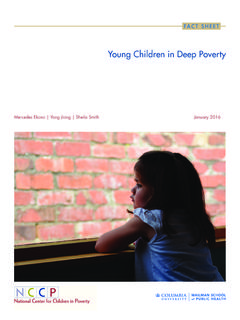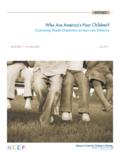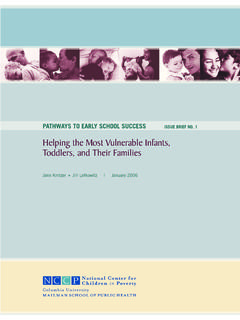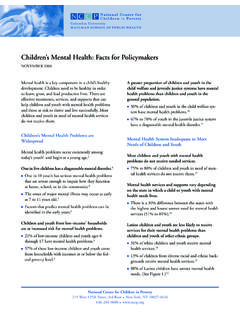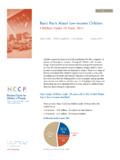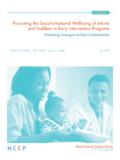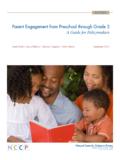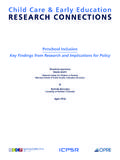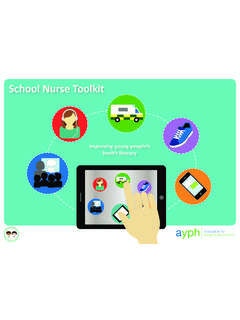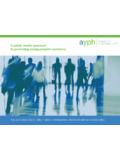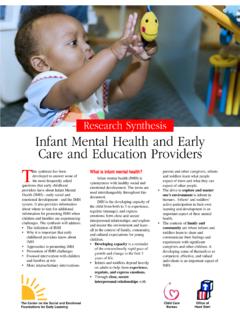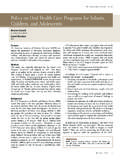Transcription of Resources to Promote Social and Emotional Health …
1 Resources to Promote Social and Emotional Health and School Readiness in young children and Families A Community Guide Jane Knitzer Jill Lefkowitz November 2005. 215 West 125th Street, 3rd oor New York, NY 10027 TEL 646-284-9600 FAX 646-284-9623. The National Center for children in Poverty identi es and promotes strategies that prevent child poverty in the United States and that improve the lives of low-income children and families. Resources to Promote Social and Emotional Health and School Readiness in young children and Families A Community Guide by Jane Knitzer and Jill Lefkowitz This document is part of a policy series intended to improve Social , Emotional , and learning outcomes for young children . Building on NCCP's work over the past several years (see Promoting the Emotional Well-Being of children and Families series, at ), Resources to Promote Social and Emotional Health and School Readiness in young children and Families A Community Guide builds on NCCP's earlier work to describe effective programs, highlight policy opportunities, and offer scal strategies to Promote the Emotional Health of young children and their families.
2 The analyses in this series will help state of cials, community leaders, and advocates take action to ensure the healthy development of children and their families. This report describes targeted interventions that can help parents and other early care providers, such as home visitors and teachers, be more effective in promoting healthy relationships and reducing challenging behavior in infants, toddlers, and preschoolers. The companion document, Spending Smarter: A Funding Guide for Policymakers and Advocates to Promote Social and Emotional Health and School Readiness, focuses on strategies to maximize existing funding streams by building on federal programs. AUTHORS. Jane Knitzer, is Executive Director at NCCP and Clinical Professor of Population and Family Health at Columbia University's Mailman School of Public Health .
3 She has contributed many important studies on how public policies can Promote the healthy development of low-income children and better support families, particularly those who are most vulnerable. Jill Lefkowitz was a Research Analyst at NCCP where she helped coordinate NCCP projects on vulnerable children , especially on projects concerning the school readiness of young , low-income children . ACKNOWLEDGMENTS. The authors gratefully acknowledge those involved in creating and implementing the programs and strategies described in this guide. They generously took the time to thoroughly explain their initiatives, answer a range of lengthy questions, and review this document. The authors would also like to thank a group of experts who reviewed this guide, providing helpful comments and insights: Lee Schorr and Vicky Marchand, Pathways Mapping Initiative; Lisa Klein, Hestia Advising; Jana Martella, Council of Chief State School Of cers; and Charles Bruner, Child and Family Policy Center.
4 Finally, the authors would like to thank Ruth Mayden and Lisa Kane of the Annie E. Casey Foundation for providing us with the support to complete this guide and their recognition of the importance of the issues it addresses. Copyright 2005 by the National Center for children in Poverty TABLE OF CONTENTS. Executive Summary.. 5. Introduction .. 13. Section I: Understanding the Challenge: Some Questions and Answers About Social and Emotional School Readiness .. 16. What does Social and Emotional development mean? .. 16. How is Social and Emotional development related to school readiness and early success in school?.. 16. What else is important for school readiness? .. 17. Why include babies and toddlers in a resource guide about school readiness and early school success?.. 17. Why focus on strategies to help parents help young children master age-appropriate Social and Emotional skills?
5 18. Why include strategies to help child care providers and teachers help young children master age-appropriate Social and Emotional skills? .. 18. Why include strategies to help the most stressed and distressed young children and families? .. 18. How can early childhood mental Health providers play a supporting role in promoting Social and Emotional Health and school readiness? .. 19. Section II: Resources to Promote Social and Emotional Competence of young children in Low-Income Communities .. 20. Resources to Help Parents Promote Social and Emotional Health and School Readiness .. 20. The Challenge .. 20. What Kinds of Resources Can Help? .. 21. Helping Babies by Helping Parents .. 21. Touchpoints . Baby FAST. Helping Preschoolers by Helping Parents .. 24. Incredible Years DARE to be You (DTBY) Family Program Parent Services Project Helping Parents Address Diversity and Promote Cultural Strengths.
6 28. The Spirit of Excellence Parent Empowerment Project Helping Parents Promote Early Literacy .. 30. Reach Out and Read (ROR). Motheread/Fatheread Other Examples What Other Strategies Can Help? .. 33. Resources to Help Child Care Providers and Teachers Who Promote Social and Emotional Competence .. 34. The Challenge .. 34. What Kinds of Resources Can Help? .. 35. Tools and Curricula .. 36. Devereux Early Childhood Assessment (DECA) Program Tools of the Mind (TOM). Other Examples What Other Strategies Can Help? .. 39. Early Childhood Mental Health Consultation Strategies Resources to Help young children and Families Facing Special Stresses .. 42. The Challenge .. 42. What Can Help? .. 43. National Center for children in Poverty Resources to Promote Social and Emotional Health and School Readiness 3.
7 Intensive Parenting Supports .. 44. Nurturing Father's Program Nurturing Program for Families in Substance Abuse Treatment and Recovery Multidimensional Treatment Foster Care-Preschool (MTFC-P). Using Early Head Start and Home Visiting Programs to Build Family and Early Childhood Treatment Partnerships .. 48. Regional Intervention Program (RIP) and the Early Childhood Centers (ECC). Positive Behavior Support (PBS). Informal Family Support Strategies to Help More Stressed Families .. 51. Raising Our children 's Kids ( ). Expanding Existing Family Support Strategies .. 52. Family Ties of Westchester, Inc. Connecting Community Assets: Building Partnerships Across Major Agencies and Funding Streams for High-Risk young children and Families .. 54. What Communities Can Do Massachusetts Early Childhood Linkage Institute Community Planning Strategies to Reduce Community Risks for young children .
8 55. Free to Grow: Head Start Partnerships to Promote Substance-Free Communities The Pima County Prevention Partnership Section III: Toward a Community Response .. 58. Step 1: Identify Leadership and Organize .. 58. Step 2: Gather Information .. 59. Step 3: Take Action .. 62. Step 4: Track Impacts .. 63. Conclusion .. 64. Endnotes .. 65. Appendix A: Contact Information for Resources .. 68. Appendix B: Other Resources Available from the National Center for children in Poverty .. 71. Appendix C: Other Useful National Organizations and Resources .. 72. LIST OF BOXES AND FIGURES. Box 1: Social , Emotional , and Behavioral Competencies That Promote School Readiness .. 16. Box 2: What Early Learning Research Tells Us .. 17. Box 3: Touchpoints in Action .. 22. Box 4: Core Family Support Principles.
9 27. Box 5: Parenting Curricula/Support Strategies in Action: Mixing and Matching to Respond to Local Needs .. 29. Box 6: Examples of Caregiver Skills to Promote Social and Emotional Competence .. 35. Box 7: Tools of the Mind in Action .. 37. Box 8: What Early Childhood Mental Health Consultants Do .. 39. Box 9: The Providence Center in Action .. 40. Box 10: A National Portrait of young children at Special Risk for Early School Failure .. 43. Box 11: Nurturing Curricula for Fathers in Action .. 45. Box 12: Positive Behavior Support in Action .. 51. Box 13: Family Ties Network in Action .. 53. Box 14: Tips on Engaging Parents .. 59. Box 15: Promoting Social and Emotional Health and School Readiness: Questions for Communities to Ask . 60. Box 16: Ten Principles for Community Action.
10 62. Figure 1: Resources to Promote Social and Emotional Health and School Readiness .. 15. 4 Resources to Promote Social and Emotional Health and School Readiness National Center for children in Poverty EXECUTIVE SUMMARY. Social and Emotional development in young children has to do with how young children feel about themselves (such as con dent, always scared, eager to learn, proud of their culture, afraid of being wrong), how they behave (such as constantly ghting, easily upset, able to deal with con ict), and how they relate to others, especially people who matter to them (for example, parents, teachers, and friends). Sometimes the terms infant and early childhood mental Health are also used instead of Social and Emotional development. When young children who do not know what to do with their anger, feel very sad, or are out-of-control enter school, many will have a hard time.
